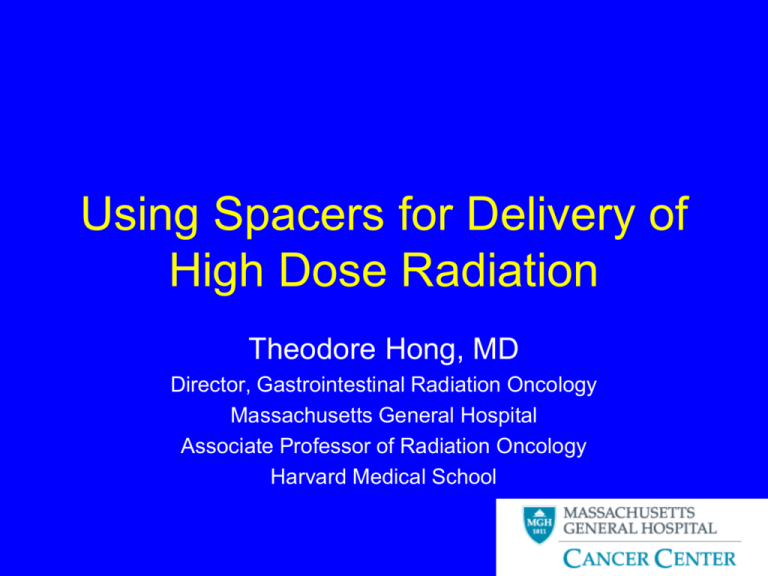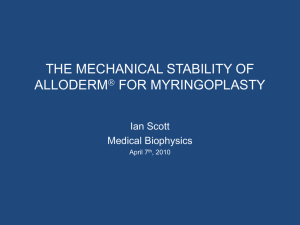the Slides - The Cholangiocarcinoma Foundation
advertisement

Using Spacers for Delivery of High Dose Radiation Theodore Hong, MD Director, Gastrointestinal Radiation Oncology Massachusetts General Hospital Associate Professor of Radiation Oncology Harvard Medical School Disclosures • No relevant financial disclosures to material in this presentation • Research Funding- Novartis • Advisory Board- Eisai The problem of bowel toxicity • High dose, advanced radiation is effective in the treatment of intrahepatic cholangiocarcinoma • Protons/IMRT can not solve the problem of tumor in contact with a mucosal surface • Solution- Manual Displacement Yoon SS, et al. Pract Radiat Oncol 2014 MGH/MDACC/UPENN phase II • 43 patients – 41 ICC, 2 mixed HCC/ICC • 4 did not receive treatment – 3 could not meet dosing constraints – 1 became ineligible due to ECOG – Median longest tumor diameter (N=3): • 6.9 cm (range 4.4 - 9.0 cm) Hong TS, et al. ASCO 2015 Treatment • 15 Fractions • Peripheral - 67.5 Gy • Central (within 2 cm porta hepatis) – 58 Gy Results • 39 analyzed – 37 ICC, 2 mixed HCC/ICC – Median age – 66 years (range 29-87 years) – Cirrhosis • None- 1 (3%) • Childs A – 34 (87%) • Childs B – 4 (10%) – Prior systemic therapy – 24 pts (62%) – Number of tumors • 1 lesion – 33 (85%) • 2 lesions – 4 (10%) • 3 lesions – 2 (5%) Results Variable Minimum Median Maximum Longest tumor dimension (cm) 2.2 5.8 10.9 CA 19-9 at baseline (u/mL) 0 72 10,549 Dose prescribed (Gy) 45 58 67.5 Dose received (Gy) 15.1 58 67.5 Gr 3 Radiation-Related Toxicity 3 pts (8%) • • • • Hyperbilirubinemia – 1 pt Stomach ulcer – 1 pt Liver failure – 1 pt Ascites – 1 pt 1 patient had both liver failure and ascites. No grade 4 radiation-related toxicities. Outcomes Median follow up duration among 19 survivors: 13.2 months (range 0.6 – 50.4 months) Endpoint 1-year 2-year Local Control 97% 90% Overall Survival 69% 44% Progression-Free Survival 40% 28% OS – All Treated Subjects n=39 PFS – All Treated Subjects n=39 Outcomes- Exclude Child’s B n=35 Median follow up duration among 18 survivors: 14.9 months (range 0.6 – 50.4 months) Endpoint 1-year 2-year Local Control 96% 90% Overall Survival 75% 48% Progression-Free Survival 45% 32% OS – Exclude Child’s B n=35 PFS – Exclude Child’s B n=35 Conclusions • High dose, hypofractionated radiation (with protons) is associated with high rates of local control in ICC • Radiation is safe • Long term survival is possible • These data form the foundation for NRG GI-001 Use of biologic spacers • Ablative radiation dose can be limited by the immediate proximity of radiationsensitive organs, including bowel • Larger issue if hypofractionated doses are used. MGH/MDACC experience • 14 patients • Retrospective review • Patients selected if tumor was in contact or within 1 cm of mucosal surface Yoon SS, et al. PRO 2014 Biologic spacer • Alloderm (Life cell) • Cadaveric human skin • Chemically processed to preserve the structural and biologically active dermal matrix. Placement • Laproscopically placed • 12 mm Hasson port placed in the periunilical position • Two 5 mm ports and one 12 mm port placed • Lysis of adhesions if necessary • Sheets of 8 x 16 cm sheets were folded into a 3 layer sandwich and sewn at four corners Placement of Spacer A C B Results: Patients with Spacers Results: Net Change with Spacers Results: Radiation Delivered Results: Radiation Therapy Toxicity Alloderm Tumor Omental fat GB Alloderm Liver Alloderm Alloderm Alloderm Alloderm Duodenum Small bowel Pre/Post Alloderm Bowel Tumor Plan Alloder m Conclusions • High dose radiation is an effective treatment for intrahepatic cholangiocarcinoma • Biologic mesh spacers can allow patients not otherwise able to be treated to receive this therapy • Biologic mesh spacers are associated with safe radiation treatments Acknowledgements • • • • • Sam Yoon, MD John Mullen, MD Alex Haynes, MD Christopher Crane, MD Jennifer Wo, MD







